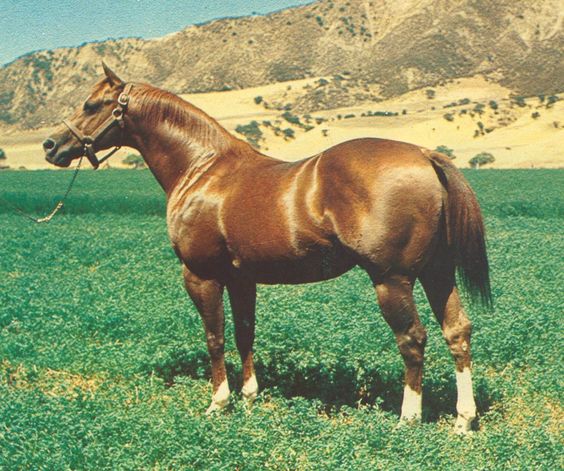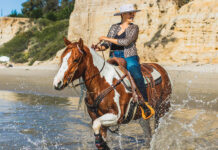It’s not often that one animal can change the entire course of its breed – but that’s exactly what a chestnut Quarter Horse by name of Doc Bar did in the latter half of the twentieth century. Considered to be among the most influential sires of cutting horses, Doc Bar was and is still hailed by Quarter Horse fanciers as a stellar specimen of the breed.
Sixty years ago, in 1956, a mare named Dandy Doll delivered a little chestnut foal on a ranch in Arizona owned by Tom Finley. The foal was named Doc Bar, continuing a line of ‘Bar’-named colts descending from his legendary grandsire Three Bars. Doc Bar’s pedigree is star-studded; on the paternal side he had almost completely Thoroughbred blood, and on the maternal side, almost completely Quarter Horse. He had several prominent stallions in his pedigree, including My Texas Dandy.
When Doc Bar was two, Finley sent him to the Quarter Horse races in Tucson in hopes of developing him as a star racer, but Doc Bar proved to be much less than a star. In four starts, he came away with less than $100 in winnings and his racing days came to a swift halt—the only thing “swift” about his career as a racer.
But his defeats on the track only paved the way for his true calling. In the show ring, Doc Bar racked up numerous championships, and his potential as a sire quickly became apparent. In 1963, Finley sold him to California ranchers Dr. and Mrs. Stephen Jensen for $30,000. You can get an idea of what an extremely valuable animal Doc Bar was by that figure; it may not seem like an exorbitant amount for a champion horse today, but when you adjust for inflation, that $30,000 investment would equal over $225,000 today. Undoubtedly, the Jensens recognized Doc Bar as a quality animal, and he proved them to be absolutely correct!

Doc Bar’s progeny took the cutting horse world by storm. Anyone familiar with the sport knows the names and achievements of such Doc Bar descendants as Doc O’Lena, Smart Little Lena, and Lynx Melody. Doc O’Lena became a prolific sire in his own right, siring over 1,300 foals.
One of the keys to Doc Bar’s success as a sire was his prepotency. He sired consistently talented, handsome offspring, and his descendants are still making their mark—they have amassed thousands of AQHA points, collectively, with the number still climbing. It’s quite clear that the influence of Doc Bar will continue to have an impact on the Quarter Horse breed for generations to come.
More Horses of History:
*Raffles
Samantha Johnson is a freelance writer and the author of several books, including The Field Guide to Horses, (Voyageur Press, 2009). She raises Welsh Mountain Ponies in northern Wisconsin and is a certified horse show judge. Follow her on Twitter: @miraclewelsh.






Good article. I’d like to correct something, however. Quarter Horses are called sorrel when they are red like Doc Bar, not chestnut. Since he was a registered Quarter and not a Thoroughbred, which breed does use the term “chestnut” for red horses, I felt a comment was in order. Chestnut usually refers to a horse with a darker body color and a much lighter mane and tail, such as a palomino. Enjoyed reading about him.
Hate to argue the “sorrel” comment…chestnut and sorrel are the same….palomino is not. Whether a horse has a red or flaxen mane does not change the base color. A palomino will have a white pearl or platinum mane/tail. Completely different from a chestnut/sorrel. In the east we call them chestnut, out west….sorrel. Still the same.
Actually, both the previous comments have incorrect info. Chestnuts, according to AQHA, are darker, red-brown. Think what most non-stock horse people would call liver chestnut or liver…. Although liver is a color in itself, I use the example to explain that chestnut is closer to that, having more brown. The bright, copper color known as chestnut to hunt riders in called sorrel in AQHA and other stock horse registries. It appears that Doc Bar was listed a chestnut on his papers. A palomino is the result of a dilution gene combined with either of the red based coat colors. Basically if you dilute the red horse you get a yellow one. A horse with a dark body and a light mane is not necessarily a palomino. 🙂
i was taught that a sorrel horse was red, or reddish/brown bodied and had a more flaxen mane and tail… a chestnut horse had a red body reddish/brown body and red mane and tail.. in the western world…. in the english world they called almost all red horses chestnuts….
also i have a doc bar son, who is registared as a sorrel..he is beddish brown with a flaxen mane and tail, though it was gotten more red as he has aged. he is now 35
For what reason,stolen herds 1982 & present I.D. theft blood stock grand theft, again 1993, 1996,1997,2004,2008,2009,2010,2011,2012,2013,2014,2014,2015,2016,2017 ?